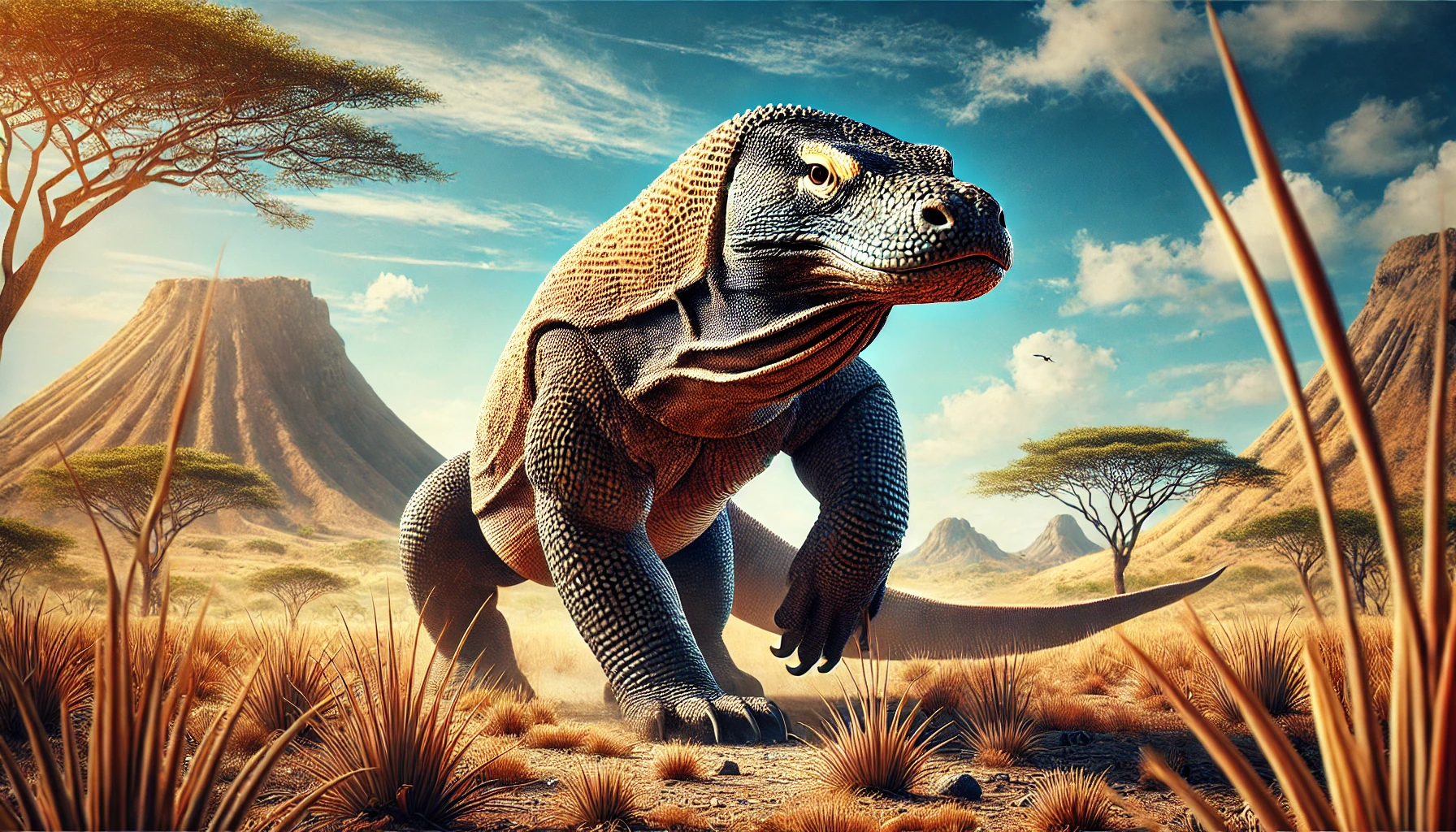Komodo dragons (Varanus komodoensis) are some of the most awe-inspiring and formidable reptiles on the planet. As the largest lizards in existence, they’ve captured the imagination of scientists, adventurers, and wildlife enthusiasts alike. Adults typically grow between 7 to 10 feet long and weigh up to 200 pounds.
These reptilian giants are native to a handful of Indonesian islands, including Komodo, Rinca, Flores, and Gili Motang. Their massive size and predatory dominance make them the apex predators in their ecosystem and certainly earn them the title of “dragons”. Let’s explore some fascinating facts about these ancient predators.

Komodo Dragon Facts
Fact 1: Incredible Sense of Smell
Komodo dragons possess an extraordinary sense of smell, which plays a crucial role in their survival as apex predators. Unlike humans, who rely primarily on their noses, Komodo dragons “smell” using their long, forked tongues. By flicking their tongues into the air, they collect scent particles, which are then analyzed by the Jacobson’s organ, a specialized sensory structure located on the roof of their mouths. This process allows them to detect prey from remarkable distances—up to 2.5 miles away under the right conditions.
Fact 2: Komodo Dragons Have a Kiss of Death
The Komodo dragon’s hunting abilities are legendary. They are ambush predators, relying on patience, camouflage, and sudden bursts of speed to overpower prey. Their diet includes deer, wild boar, smaller reptiles, and even water buffalo. Remarkably, Komodo dragons can consume up to 80% of their body weight in a single meal.
What makes their bite so unique is its combination of raw power and biological weaponry. Komodo dragons were once thought to kill prey through bacteria in their saliva, but recent studies suggest venom glands in their jaws play a significant role. The venom contains proteins that prevent blood clotting and cause rapid blood loss, shock, and paralysis in their victims, ensuring a swift kill.
Fact 3: Keen Survivalists
Komodo dragons are highly adapted to their harsh environments, including arid savannas and tropical forests. They are cold-blooded reptiles, relying on external heat sources to regulate their body temperature. During cooler parts of the day, they bask in the sun, and during the hottest hours, they retreat to burrows dug into the ground.
Their ability to survive on limited food resources is another testament to their resilience. Komodo dragons have a slow metabolism, allowing them to go weeks without eating after a large meal. They can even scavenge carcasses when hunting opportunities are scarce, using their acute sense of smell to detect dead or dying animals from miles away.
Fact 4: Komodo Dragons are Marathon Sprinters
Despite their bulky and somewhat sluggish appearance, Komodo dragons are surprisingly agile and capable of bursts of remarkable speed. On land, they can sprint at speeds of up to 13 miles per hour (21 kilometers per hour) over short distances. This ability is crucial for their role as ambush predators, allowing them to quickly close the gap between themselves and unsuspecting prey.
However, their speed is not suited for prolonged chases. As cold-blooded reptiles, Komodo dragons lack the endurance required for long-distance pursuits. Instead, they conserve their energy for short, decisive bursts, typically striking from a concealed position. This ambush strategy not only maximizes their hunting efficiency but also minimizes the energy they expend—an important consideration in their challenging, resource-scarce habitats.
A Species Under Threat
Despite their fearsome reputation, Komodo dragons are vulnerable to extinction. Habitat loss due to human activity, including deforestation and agricultural expansion, is one of the biggest threats to their survival. Rising sea levels caused by climate change also threaten the low-lying islands they inhabit.
The International Union for Conservation of Nature (IUCN) lists Komodo dragons as Endangered, with fewer than 3,000 individuals estimated to remain in the wild. Efforts to conserve them include the establishment of Komodo National Park, a UNESCO World Heritage Site that protects their natural habitat. Ecotourism has also played a role in raising awareness about these incredible reptiles while providing funding for their conservation.
Komodo Dragon EcoTourism Support
Ecotourism plays a vital role in the conservation of Komodo dragons by promoting sustainable travel practices that support both the environment and local communities. Here are some reputable ecotourism operators and organizations dedicated to preserving Komodo dragons and their natural habitat:
- Komodo National Park Authority – Labuan Bajo, Indonesia – The official body managing Komodo National Park, focusing on conservation and sustainable tourism to protect the Komodo dragon’s habitat.
- Maika Komodo Tour & Diving – Labuan Bajo, Indonesia – A local operator offering eco-conscious tours and liveaboard diving experiences, contributing to the local economy and conservation efforts.
- Indonesia Juara – Jakarta, Indonesia – Promotes ecotourism in Komodo National Park, emphasizing habitat conservation and community empowerment.
- Plataran Komodo Resort & Spa – Labuan Bajo, Indonesia – An eco-friendly resort offering sustainable tourism experiences, supporting local conservation initiatives.
- The Blue of Indonesia – Bali, Indonesia – Focuses on ecotourism and conservation education, including efforts related to Komodo dragons.

